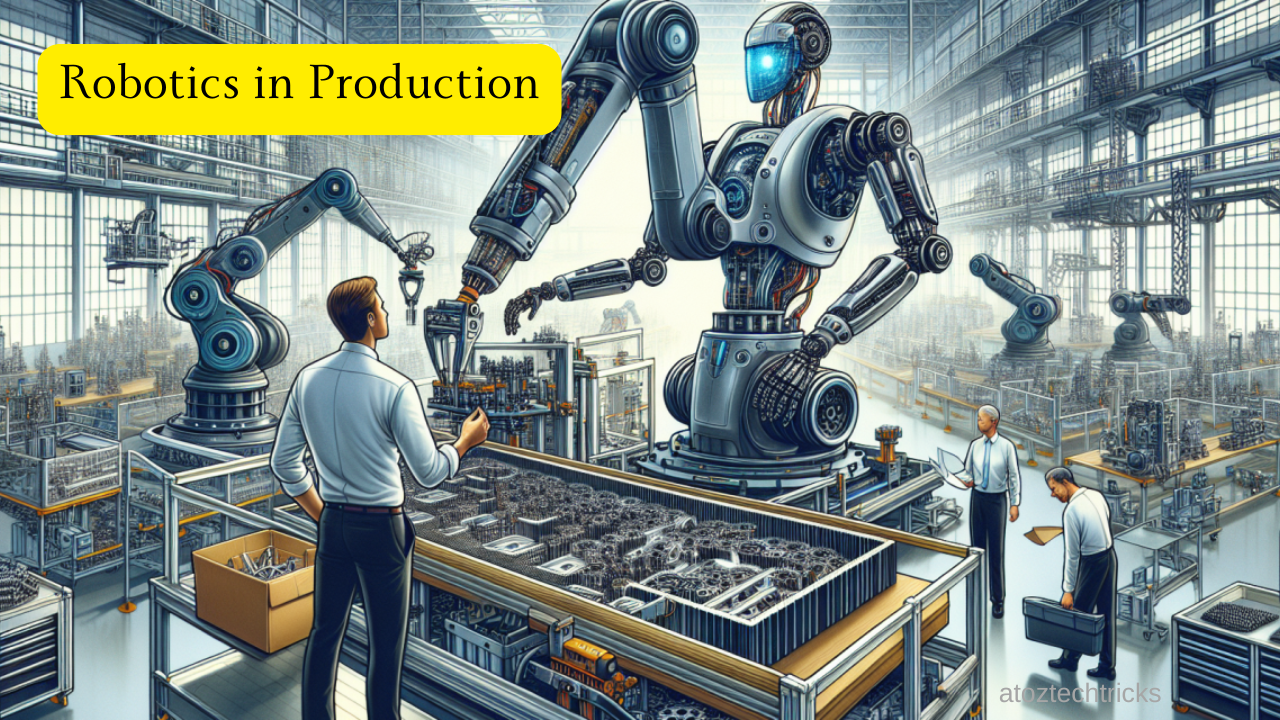Revolutionizing Manufacturing: The Role of Robotics in Production
In recent years, robotics has revolutionized manufacturing and production processes, driving efficiency, precision, and innovation across various industries. The integration of robots into manufacturing systems has not only transformed traditional practices but also paved the way for advanced automation and smart production. This article delves into the diverse applications of robotics in manufacturing, explores the benefits and challenges associated with their use, and examines future trends that will shape the industry’s evolution.
Historical Context
Early Automation
The concept of automation in manufacturing can be traced back to the early 20th century with the advent of the assembly line. Henry Ford’s introduction of the moving assembly line in 1913 marked a significant milestone, laying the foundation for modern manufacturing practices. Although these early systems did not involve robots, they set the stage for the automation advancements that followed.
Emergence of Industrial Robots
The term “robot” was first popularized in 1921 by Karel Čapek’s play “R.U.R.” (Rossum’s Universal Robots). However, it wasn’t until the 1960s that robots began to make a tangible impact on manufacturing. The first industrial robot, Unimate, was installed in a General Motors plant in 1961, marking the beginning of a new era in automation.

Types of Industrial Robots
Articulated Robots
Articulated robots, often referred to as robotic arms, are characterized by their multiple joints and degrees of freedom. These robots are versatile and capable of performing a wide range of tasks, from welding and painting to assembly and material handling. Their flexibility makes them ideal for complex and precise operations.
SCARA Robots
Selective Compliance Assembly Robot Arm (SCARA) robots are designed for high-speed assembly and precision tasks. They have a rigid vertical movement and a flexible horizontal movement, making them suitable for tasks such as picking, placing, and assembling small parts.
Delta Robots
Delta robots, also known as parallel robots, feature a unique design with three arms connected to a common base. Their high-speed operation and accuracy make them ideal for applications such as packaging, sorting, and assembling lightweight objects.
Collaborative Robots (Cobots)
Collaborative robots, or cobots, are designed to work alongside human operators in a shared workspace. Unlike traditional industrial robots, cobots are equipped with sensors and safety features to ensure safe interaction with human workers. They are increasingly used in tasks that require human-robot collaboration, such as light assembly and quality inspection.
Robotics in Healthcare and Medicine: Revolutionizing Patient Care and Treatment
Applications of Robotics in Manufacturing
Automotive Industry
Robotics has had a profound impact on the automotive industry, streamlining production processes and enhancing quality. Robots are extensively used in tasks such as welding, painting, and assembly. For instance, robotic arms perform precise welding on car bodies, ensuring consistent weld quality and reducing manual labour. Additionally, robots are employed in painting booths to achieve uniform coating and minimize overspray.
Electronics Manufacturing
In electronics manufacturing, robots play a crucial role in handling delicate components and assembling intricate circuits. Their precision and repeatability are essential for tasks such as soldering, component placement, and inspection. Automated systems are also used for packaging and testing electronic devices, improving overall efficiency and reducing errors.
Consumer Goods
Robotics has revolutionized the production of consumer goods, including food and beverages, pharmaceuticals, and household products. Robots are used in various stages of production, from sorting and packaging to quality control and palletizing. In the food industry, for example, robots handle tasks such as sorting fruits, packaging snacks, and ensuring adherence to hygiene standards.
Aerospace Industry
The aerospace industry relies heavily on robotics for tasks that require extreme precision and consistency. Robots are employed in the assembly of aircraft components, such as fuselages and wings, as well as in the inspection and maintenance of aircraft. Their ability to perform repetitive tasks with high accuracy ensures the safety and reliability of aerospace products.

Benefits of Robotics in Manufacturing
Enhanced Efficiency
One of the primary advantages of robotics in manufacturing is increased efficiency. Robots can operate continuously without fatigue, leading to higher production rates and reduced downtime. Automated systems streamline workflows, minimize bottlenecks, and ensure consistent output quality.
Improved Precision and Quality
Robots are known for their precision and accuracy, which are crucial in manufacturing processes that demand high standards of quality. With advanced sensors and control systems, robots can perform tasks with minimal deviation, reducing defects and ensuring product consistency.
Cost Savings
While the initial investment in robotics can be significant, the long-term cost savings are substantial. Robots reduce the need for manual labour, lower production costs, and minimize waste. Additionally, automation can lead to higher throughput, allowing manufacturers to meet increased demand without additional labour costs.
Enhanced Safety
Robots can perform hazardous tasks in environments that may be dangerous for human workers. For example, robots can handle toxic materials, work in high-temperature environments, and perform repetitive tasks that may lead to musculoskeletal injuries in humans. By taking on these risky activities, robots help improve workplace safety.
Flexibility and Scalability
Robotic systems offer flexibility and scalability, allowing manufacturers to adapt to changing production requirements. Programmable robots can be reconfigured for different tasks or products, making it easier to introduce new products or adjust production volumes.
Understanding the Impact of Robotics on the Job Market: What You Need to Know
Challenges and Considerations
High Initial Costs
One of the main challenges associated with robotics in manufacturing is the high initial investment. The cost of purchasing, installing, and integrating robotic systems can be substantial, particularly for small and medium-sized enterprises (SMEs). However, the long-term benefits often outweigh the initial costs.
Technical Complexity
Implementing and maintaining robotic systems requires specialized knowledge and technical expertise. Manufacturers need skilled personnel to program, operate, and troubleshoot robots. The complexity of integrating robots into existing production systems can also pose challenges.
Workforce Displacement
The automation of manufacturing processes can lead to workforce displacement, as robots may replace certain manual jobs. This shift highlights the need for workforce retraining and upskilling programs to help workers transition to new roles in a more automated environment.
Maintenance and Downtime
While robots can operate continuously, they are not immune to breakdowns and maintenance issues. Regular maintenance and timely repairs are essential to minimize downtime and ensure the continued efficiency of robotic systems.
Ethical and Social Implications
The widespread use of robotics in manufacturing raises ethical and social considerations, including the impact on employment and the need for equitable access to technological advancements. Addressing these issues requires thoughtful planning and collaboration between industry stakeholders and policymakers.

Future Trends in Robotics
Artificial Intelligence and Machine Learning
The integration of artificial intelligence (AI) and machine learning (ML) into robotics is expected to drive significant advancements in manufacturing. AI-powered robots can learn from their experiences, adapt to new tasks, and make real-time decisions based on data analysis. This capability will enhance the flexibility and efficiency of robotic systems.
Industry 4.0 and Smart Manufacturing
The concept of Industry 4.0, characterized by the integration of cyber-physical systems, the Internet of Things (IoT), and data analytics, is transforming manufacturing. Robotics will play a key role in smart manufacturing environments, where interconnected systems communicate and collaborate to optimize production processes.
Collaborative Robotics
The continued development of collaborative robots (cobots) will enable more seamless human-robot interaction. Future cobots will feature advanced safety measures, intuitive programming interfaces, and enhanced adaptability, allowing them to work alongside human operators more effectively.
Advanced Sensors and Perception
Advancements in sensor technology and perception systems will enhance the capabilities of robots in manufacturing. High-resolution cameras, lidar, and other sensors will enable robots to perform more complex tasks, such as quality inspection and autonomous navigation, with greater accuracy.
Sustainability and Green Manufacturing
Robotics will play a crucial role in promoting sustainability and green manufacturing practices. Automated systems can optimize resource usage, reduce waste, and support eco-friendly production processes. The development of energy-efficient robots and sustainable materials will contribute to a more environmentally conscious manufacturing sector.
Discovering the Limitless Possibilities: The Role of Robotics in Space Exploration
The use of robotics in manufacturing and production has transformed the industry, driving efficiency, precision, and innovation. From automotive and electronics to consumer goods and aerospace, robots have become integral to modern manufacturing processes. While there are challenges associated with robotics, including high initial costs and workforce displacement, the benefits far outweigh the drawbacks. As technology continues to advance, robotics will play an increasingly central role in shaping the future of manufacturing, driving progress in artificial intelligence, smart manufacturing, and sustainability. Embracing these advancements will enable manufacturers to stay competitive in a rapidly evolving industry and unlock new possibilities for growth and innovation.




Post Comment